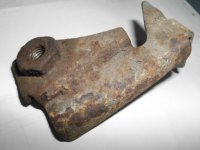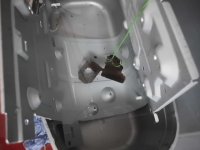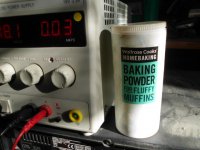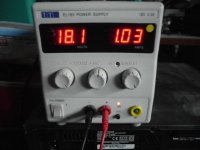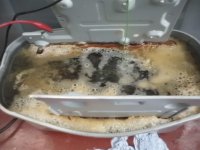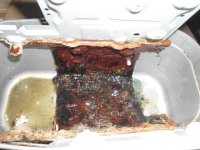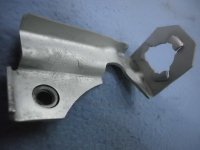How to remove rust with just water .
No kidding this is true, and it uses a little known technique of electrolysis .
I am currently re building a Fiat Tipo 1.6 DGT , I am removing every part and de rusting , re painting and putting the car back together to make the ultimate Tipo
So here is how its done , First you need a container that the rusted part will fit into , Here I am de rusting a bracket that holds the flexible rubber brake pipe on the rear subframe of the car.
You also need a DC power source , I am an electronics engineer so I have a few to hand but you could use a 12 volt car battery charger.
Connect the NEGATIVE of the power source to part you want to de rust , the polarity is VERY important, then you need an old steel plate , I have used the back panel from a old flat screen TV set , bend this into a U shape and place it into a plastic container , connect your POSITIVE of the power source to this metal plate.
Now suspend the rusted item in close proximity with the U shaped metal plate but dont let the two touch as it will make a short circuit.
Fill the container to the top with water from the tap and switch on the power source, if you power source has a amp meter like mine you will see the current consumption is only in the order of a few milliamps due to the relatively high resistance of the water , now we need to lower the resistance of the water so you can pass a larger current through the water , I am using a few big tablespoons of baking powder , stir this into the water and you will see a big increase in the current consumption , in my photo the water is now passing over 1 amp.
The baking powder serves no purpose whatsoever in the removal of rust, it is only added to reduce the resistance of the water.
Now just leave it running , for best results I leave it for a couple of days for the magic to happen , by electrolytic action all the rust and dirt will be liberated from from the metal item connected to the negative pole and will collect of the POSITIVE pole which is the sheet metal in the container.
A word of warning though, you will see bubbles emerging from the water , this is HYDROGEN GAS and if you make a spark there is going to be one hell of a bang , I did this once and it shook me up ! so do this is a well ventilated space .
After a couple of days the current consumption will have reduced , this is due to migratory rust building up on the collector plate and also a good indication the the part has been de rusted.
As rust migrates you will see the water goes brown, this means its working.
Switch off the power and remove the de rusted item , you will see it comes out black and very dirty, you can now either scrub the black off with a tooth brush and running water or my preferred method is to let the part sit on a shop bought bare metal rust remover to microscopically deep clean the item, a quick wash in clean water, dry with hairdryer and paint immediately .
The last photo with green wire shows the item in bare metal just after removal from the electrolysis bath and washing under the tap, you can see how dirty it is , The very last photo shows the item after removal from the shop bought deep clean rust remover, this has not yet been painted.
Of course you could achieve the same results by just using a shop bought bare metal rust remover but its expensive and its effectiveness reduces the more times its used, electrolysis rust removal will cost you just some water, baking powder , and a bit of electricity.
Any DC voltage of between 12 - 30 volts at 1- 5 amps will do fine , its not critical at all , BUT you must get the polarity right, Negative to the rusted item and Positive to the collector plate , in order to get a good connection to the rusted item you may need to scrape a bit of rust off first so you can make a good connection .
No kidding this is true, and it uses a little known technique of electrolysis .
I am currently re building a Fiat Tipo 1.6 DGT , I am removing every part and de rusting , re painting and putting the car back together to make the ultimate Tipo
So here is how its done , First you need a container that the rusted part will fit into , Here I am de rusting a bracket that holds the flexible rubber brake pipe on the rear subframe of the car.
You also need a DC power source , I am an electronics engineer so I have a few to hand but you could use a 12 volt car battery charger.
Connect the NEGATIVE of the power source to part you want to de rust , the polarity is VERY important, then you need an old steel plate , I have used the back panel from a old flat screen TV set , bend this into a U shape and place it into a plastic container , connect your POSITIVE of the power source to this metal plate.
Now suspend the rusted item in close proximity with the U shaped metal plate but dont let the two touch as it will make a short circuit.
Fill the container to the top with water from the tap and switch on the power source, if you power source has a amp meter like mine you will see the current consumption is only in the order of a few milliamps due to the relatively high resistance of the water , now we need to lower the resistance of the water so you can pass a larger current through the water , I am using a few big tablespoons of baking powder , stir this into the water and you will see a big increase in the current consumption , in my photo the water is now passing over 1 amp.
The baking powder serves no purpose whatsoever in the removal of rust, it is only added to reduce the resistance of the water.
Now just leave it running , for best results I leave it for a couple of days for the magic to happen , by electrolytic action all the rust and dirt will be liberated from from the metal item connected to the negative pole and will collect of the POSITIVE pole which is the sheet metal in the container.
A word of warning though, you will see bubbles emerging from the water , this is HYDROGEN GAS and if you make a spark there is going to be one hell of a bang , I did this once and it shook me up ! so do this is a well ventilated space .
After a couple of days the current consumption will have reduced , this is due to migratory rust building up on the collector plate and also a good indication the the part has been de rusted.
As rust migrates you will see the water goes brown, this means its working.
Switch off the power and remove the de rusted item , you will see it comes out black and very dirty, you can now either scrub the black off with a tooth brush and running water or my preferred method is to let the part sit on a shop bought bare metal rust remover to microscopically deep clean the item, a quick wash in clean water, dry with hairdryer and paint immediately .
The last photo with green wire shows the item in bare metal just after removal from the electrolysis bath and washing under the tap, you can see how dirty it is , The very last photo shows the item after removal from the shop bought deep clean rust remover, this has not yet been painted.
Of course you could achieve the same results by just using a shop bought bare metal rust remover but its expensive and its effectiveness reduces the more times its used, electrolysis rust removal will cost you just some water, baking powder , and a bit of electricity.
Any DC voltage of between 12 - 30 volts at 1- 5 amps will do fine , its not critical at all , BUT you must get the polarity right, Negative to the rusted item and Positive to the collector plate , in order to get a good connection to the rusted item you may need to scrape a bit of rust off first so you can make a good connection .
Attachments
Last edited:


